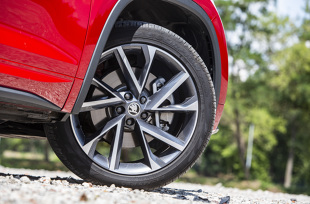
adaptive suspension. A way to increase security
 A well-designed suspension affects not only traction and driving comfort, but also safety. A modern solution is the adaptive suspension, which adapts to the types of road surface and the driver's driving style.
A well-designed suspension affects not only traction and driving comfort, but also safety. A modern solution is the adaptive suspension, which adapts to the types of road surface and the driver's driving style.
– The braking distance, the efficiency of turning and the correct operation of the electronic driving assistance systems depend on the setting and technical condition of the suspension, explains Radosław Jaskulski, instructor at Skoda Auto Szkoła.
One of the most advanced types of suspension is the adaptive suspension. This type of solution is no longer just for higher class vehicles. They are also used in their models by car manufacturers for a wide range of customers, such as, for example, Skoda. The system is called Dynamic Chassis Control (DCC) and is used in the following models: Octavia (also Octavia RS and RS245), Superb, Karoq and Kodiaq. Thanks to DCC, the driver can adjust the suspension characteristics either to the road conditions or to their individual preferences.
 The DCC system uses variable damping shock absorbers that control the flow of oil, a substance responsible for reducing shock loads. An electronically controlled valve is responsible for this, which receives data based on road conditions, the driver's driving style and the selected driving profile. If the valve in the shock absorber is fully open, then the bumps are damped most efficiently, i.e. The system provides a high driving comfort. When the valve is not fully open, damper oil flow is controlled, which means the suspension becomes stiffer, reducing body roll and contributing to a more dynamic driving experience.
The DCC system uses variable damping shock absorbers that control the flow of oil, a substance responsible for reducing shock loads. An electronically controlled valve is responsible for this, which receives data based on road conditions, the driver's driving style and the selected driving profile. If the valve in the shock absorber is fully open, then the bumps are damped most efficiently, i.e. The system provides a high driving comfort. When the valve is not fully open, damper oil flow is controlled, which means the suspension becomes stiffer, reducing body roll and contributing to a more dynamic driving experience.
The DCC system is available in conjunction with the Driving Mode Select System, which allows certain vehicle parameters to be tailored to the needs and preferences of the driver. We are talking about the characteristics of the drive, shock absorbers and steering. The driver decides which profile to choose and can enable one of several available options. For example, in the Skoda Kodiaq, the user can choose as many as 5 modes: Normal, Eco, Sport, Individual and Snow. The first is a neutral setting, adapted to normal driving on asphalt surfaces. Economy mode gives priority to optimal fuel consumption, i.e. the system first measures the fuel dose to ensure economical combustion. The sport mode is responsible for good dynamics, i.e. smooth acceleration and maximum cornering stability. In this mode, the suspension is stiffer. Individually adapts to the driver's driving style. The system takes into account, among other things, the way the accelerator pedal is operated and the movement of the steering wheel. Snow mode is designed for driving on slippery surfaces, especially in winter. Engine torque measurement becomes more muted, as does steering system operation.
The advantage of the DCC system, among other things, is the readiness to react in extreme situations. If one of the sensors detects an abrupt behavior of the driver, such as a sudden maneuver when avoiding an obstacle, DCC adjusts the appropriate settings (increased stability, better traction, shorter braking distance) and then returns to the previously set mode.
Thus, the DCC system means not only greater driving comfort, but, above all, greater safety and control over the behavior of the car.

